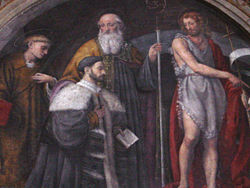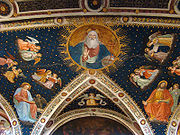
San Maurizio al Monastero Maggiore
Encyclopedia
_-_vedute_di_milano_-_84_-_il_monastero_maggiore_monache_-_ca._1745.jpg)


Milan
Milan is the second-largest city in Italy and the capital city of the region of Lombardy and of the province of Milan. The city proper has a population of about 1.3 million, while its urban area, roughly coinciding with its administrative province and the bordering Province of Monza and Brianza ,...
, northern Italy
Italy
Italy , officially the Italian Republic languages]] under the European Charter for Regional or Minority Languages. In each of these, Italy's official name is as follows:;;;;;;;;), is a unitary parliamentary republic in South-Central Europe. To the north it borders France, Switzerland, Austria and...
. It was originally attached to the most important female convent of the Benedictine
Benedictine
Benedictine refers to the spirituality and consecrated life in accordance with the Rule of St Benedict, written by Benedict of Nursia in the sixth century for the cenobitic communities he founded in central Italy. The most notable of these is Monte Cassino, the first monastery founded by Benedict...
s in the city, Monastero Maggiore, which is now in use as an archaeological museum. The church today is used by the Italo-Greek Catholic Church
Italo-Greek Catholic Church
The Italo-Greek Catholic Church is one of the 22 Eastern Catholic Churches which, together with the Latin Church, comprise the Catholic Church...
and it is also used as concert hall.
History
The complex was founded in LombardLombards
The Lombards , also referred to as Longobards, were a Germanic tribe of Scandinavian origin, who from 568 to 774 ruled a Kingdom in Italy...
times, partially re-using ancient Roman edifices
Mediolanum
Mediolanum, the ancient Milan, was an important Celtic and then Roman centre of northern Italy. This article charts the history of the city from its settlement by the Insubres around 600 BC, through its conquest by the Romans and its development into a key centre of Western Christianity and capital...
. Of these there remain a polygonal tower, a relic of the ancient Maximian
Maximian
Maximian was Roman Emperor from 286 to 305. He was Caesar from 285 to 286, then Augustus from 286 to 305. He shared the latter title with his co-emperor and superior, Diocletian, whose political brain complemented Maximian's military brawn. Maximian established his residence at Trier but spent...
walls, and a square one, originally part of the lost Hippodrome
Hippodrome
A hippodrome was a Greek stadium for horse racing and chariot racing. The name is derived from the Greek words "hippos and "dromos"...
and later adopted as the church’s bell tower. The monastery is now home to Milan's Archaeological Museum.

Gian Giacomo Dolcebuono
Gian Giacomo Quadri, known as Dolcebuono was an Italian architect and sculptor.Born probably in Lugano, he was a relative of Giacomo Antonio Dolcebuono, who had provided one of the first projects for the façade of the Certosa di Pavia. Quadri apprenticed in the Milanese workshop of Giovanni and...
in collaboration with Giovanni Antonio Amadeo
Giovanni Antonio Amadeo
thumb|260px|The Colleoni Chapel in Bergamo.Giovanni Antonio Amadeo was an Italian early Renaissance sculptor, architect, and engineer....
. The edifice was finished fifteen years later by Cristoforo Solari
Cristoforo Solari
Cristoforo Solari , also known as il Gobbo , was an Italian sculptor and architect. He was the brother of the painter Andrea Solari....
, divided into two parts: one for the faithful, one for the nuns. Until 1794 the latter were strongly forbidden to cross the dividing wall.
Description
The façade is covered with gray stone from OrnavassoOrnavasso
Ornavasso is a comune in the Province of Verbano-Cusio-Ossola in the Italian region Piedmont, located about 110 km northeast of Turin and about 11 km northwest of Verbania....
.
The interior has a vaulted nave separated by the divisory wall (the nuns followed the mass from a grating) and flanked by groin-vaulted chapels, which are surmounted by a serliana loggia.
The most important artwork of the church is the cycle of frescoes from the 16th century covering the walls. The dividing wall has frescoes by Bernardino Luini
Bernardino Luini
Bernardino Luini was a North Italian painter from Leonardo's circle. Both Luini and Giovanni Antonio Boltraffio were said to have worked with Leonardo directly; he was described to have taken "as much from Leonardo as his native roots enabled him to comprehend". Consequently many of his works were...
which flank an altarpiece with an Adoration of the Magi by Antonio Campi
Antonio Campi
Antonio Campi was an Italian painter of the Renaissance.He was born in Cremona. His style merges Lombard with Mannerist styles. In Cremona, his extended family were the main artistic produce. Giulio Campi and Antonio were reportedly half-brothers, while Vincenzo Campi was a full brother....
. The chapels in the faithful's area are by Aurelio Luini
Aurelio Luini
thumb|250px|Ol compà Digliagòr and Ol compà Braghetògn , two caricatures. [[Pinacoteca Ambrosiana]], [[Milan]].Aurelio Luini was an Italian painter and draughtsman from Milan, the fourth and last son of Bernardino Luini...
, son of Bernardino, and his brothers. The counterfaçade has a fresco by Simone Peterzano
Simone Peterzano
Simone Peterzano was an Italian painter of the later Mannerism, native of Bergamo. He is mostly known as the master of Caravaggio....
(1573). In the right side Bernardino Luini also frescoed the Chapel of St. Catherine of Alexandria (1530).
In the nuns' side is a 1554 organ and notable frescoes in the presbytery
Presbytery (architecture)
The presbytery is the name for an area in a church building which is reserved for the clergy.In the oldest church it is separated by short walls, by small columns and pilasters in the Renaissance ones; it can also be raised, being reachable by a few steps, usually with railings....
.

